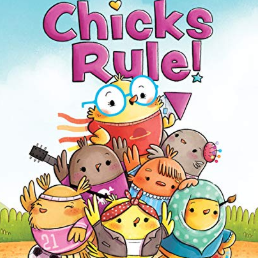Building Community Read Alouds
Family
My Family, Your Family
by Lisa Bullard
Makayla is visiting friends in her neighborhood. She sees how each family is different. Some families have lots of children, but others have none. Some friends live with grandparents, or have two dads, or have parents who are divorced. How is her own family like the others? What makes each one great? This diverse cast allows readers to compare and contrast families in multiple ways.
The Family Book
by Todd Parr
The Family Book celebrates the love we feel for our families and all the different varieties they come in. Whether you have two moms or two dads, a big family or a small family, a clean family or a messy one, Todd Parr assures readers that no matter what kind of family you have, every family is special in its own unique way.
A Family is a Family
by Sara O’Leary
When a teacher asks the children in her class to think about what makes their families special, the answers are all different in many ways — but the same in the one way that matters most of all. The students describe who they live with and who loves them — family of every shape, size and every kind of relation — the child realizes that as long as her family is full of caring people, it is special.
Our School is a Family
by Shannon Olsen
“Our Class is a Family” is a book that will help build and strengthen that class community. Kids learn that their classroom is a place where it’s safe to be themselves, it’s okay to make mistakes, and it’s important to be a friend to others. When hearing this story being read aloud by their teacher, students are sure to feel like they are part of a special family.
Community
All Are Welcome
by Alexandra Penfold
Follow a group of children through a day in their school, where everyone is welcomed with open arms. A school where kids in patkas, hijabs, and yarmulkes play side-by-side with friends in baseball caps. A school where students grow and learn from each other’s traditions and the whole community gathers to celebrate the Lunar New Year.
Chicks Rule
by S. Bardhan-Quillan
Nerdy Chick has waited all day for the Rocket Club meeting. But when she gets there, she finds a sign tacked to the door: “NO CHICKS ALLOWED!!!” Puzzled, then baffled, then just plain mad, Nerdy Chick sets out to change the rules. Along the way, she meets other chicks who are just like her: passionate and determined. They rally together, march to the barn at the center of town, and—when they hear “NO” once again—chart their own path forward.
We Are All Alike; We Are All Different
Cheltenham Elementary Kindergartners
Kindergarten children describe the likenesses and differences among themselves.
It's Okay to be Different
by Todd Parr
It’s Okay to Be Different cleverly delivers the important messages of acceptance, understanding, and confidence, This book will inspire kids to celebrate their individuality through acceptance of others and self-confidence.
The Big Umbrella
by Amy June Bates
By the door there is an umbrella. It is big. It is so big that when it starts to rain there is room for everyone underneath. It doesn’t matter if you are tall. Or plaid. Or hairy. It doesn’t matter how many legs you have.
Home
by Carson Ellis
Home might be a house in the country, an apartment in the city, or even a shoe. Home may be on the road or the sea, in the realm of myth, or in the artist’s own studio.
Here We Are
by Oliver Jeffers
Our world can be a bewildering place so let’s explore what makes our planet and how we live on it. From land and sky, to people and time, these notes can be your guide and start you on your journey. And you’ll figure lots of things out for yourself. Just remember to leave notes for everyone else. Some things about our planet are pretty complicated, but things can be simple, too: you’ve just got to be kind.
Maybe Something Beautiful
by F. Isabel Campoy and Theresa Howell
This joyful story about a girl and a muralist who transform a grey neighbourhood by bringing the community together with art is based on the true story of the Urban Art Trail in San Diego, California.
Windows
by Julia Denos
Walking his dog at dusk, one boy catches glimpses of the lives around him in this lovely ode to autumn evenings, exploring your neighborhood, and coming home.
Most Marshmallows
by Rowboat Watkins
Most marshmallows are born into marshmallow families, play with marshmallow friends, and go to marshmallow school where they learn to be squishy. But some marshmallows have big dreams, and just like you, these marshmallows can do anything they set their minds to. This sweet and silly book is an inspiring reminder that by being true to ourselves each of us can be truly extraordinary.
What Makes Us Unique?
by Jillian Roberts
When it comes to explaining physical, cultural and religious differences to children, it can be difficult to know where to begin. What Makes Us Unique? provides an accessible introduction to the concept of diversity, teaching children how to respect and celebrate people’s differences and that ultimately, we are all much more alike than we are different.
Same, Same But Different
by Jenny Sue Kostecki-Shaw
Elliot lives in America, and Kailash lives in India. They are pen pals. By exchanging letters and pictures, they learn that they both love to climb trees, have pets, and go to school. Their worlds might look different, but they are actually similar. Same, same. But different!

On Our Street
by Jillian Roberts
On Our Street explores the realities of people living with inadequate resources. Using age-appropriate language, this book addresses mental illness, homelessness and refugee status as they are connected to this issue. Insightful quotes from individuals and organizations such as UNICEF are included to add further perspective on the issue. An invaluable section on how kids can help empowers readers to take what they have learned and use it to make a difference.
This Is How We Do It: One Day In The Lives Of Seven Kids From Around The World
by Matt Lamothe
Follow one day in the real lives of seven kids from around the world-Italy, Japan, Iran, India, Peru, Uganda, and Russia!
If the World Were a Village
by David J. Smith
Now, If the World Were a Village has been newly revised with updated statistics, several new activities and completely new material on food security, energy and health. By exploring the lives of the 100 villagers, children will discover that life in other nations is often very different from their own.
Same Difference
by Calida Garcia Rawles
Same Difference addresses the sensitive and sometime divisive issues of beauty and identity. It has a lyrical, upbeat air that begs to be read aloud and offers an engaging rhyme pattern for young children. Vivid illustrations capture the spirit and innocence of Lida and Lisa, two first cousins who find themselves at odds with each other over their physical differences. With the help of their wise grandmother, the girls soon realize that their bond is deeper than what they see and our differences are what make us beautiful.
Good Manners
Do Unto Otters: A Book About Manners
by Laurie Keller
Mr. Rabbit’s new neighbors are Otters. But he doesn’t know anything about otters. Will they get along? Will they be friends? Just treat otters the same way you’d like them to treat you, advises Mr. Owl.
Rude Cakes
by Rowboat Watkins
A not-so-sweet cake-who never says please or thank you or listens to its parents learns that even the rudest cake can learn to change its ways.
Use Polite Words – Animated Lesson with Sign Language
Apologizing

Sorry
by Trudy Ludwig
Jack’s friend Charlie seems to know how to get away with just about anything. Adults always back down when you say you’re sorry. But does an apology count if you don’t really mean it? Jack learns that the path to forgiveness isn’t always the easiest. Includes afterword by apology-expert Dr. Aaron Lazare, M.D., note from author, and discussion questions.

Tomato Says Sorry
by Joanne Roach
Tomato upsets his friends and refuses to apologize until he learns that apologizing can make him feel better too.

Start with Sorry
by P.T. Finch
Luna gets jealous and angry when she is drawing with her brother. She makes a mistake and learns that she can offer a good apology to help make things better.
Teacher Resources:

The First Six Weeks of School
Day by day and week by week, The First Six Weeks of School shows K-6 teachers how to set students up for a year of engaged and productive learning by using positive teacher language to establish high academic and behavioral expectations; and teaching the classroom and academic routines that enable a collaborative learning community to thrive.





















